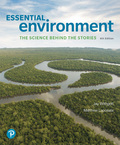
The region of exposure to lead, asbestos, radon, and PBDEs.
Answer to Problem 3TYC
The harmful chemical compounds such as lead, asbestos, radon, and PBDEs are indoor hazards that cause detrimental effects on human health.
Explanation of Solution
Toxicity is defined as the degree at which a chemical substance harms humans and animals. Toxic substance occurs either naturally in nature or is synthesized artificially in laboratories. It causes adverse effects on human health and disrupts various physiological and physical functions of cell.
The region of exposure to harmful chemicals is described as below:
Radon is a radioactive gas which is released from cigarette smoke and is one of the most harmful indoor hazards that causes lung cancer.
Asbestos are chemicals that are used as insulation in walls and other products and affect the health when inhaled.
Lead poisoning is caused from water pipes or lead paints that are used to paint walls. It causes serious cognitive problems, behavioral abnormalities, damage to vital organs and leads to death.
PBDEs are polybrominated diphenyl ethers. They are used as fire retardants in computers, televisions, plastics, and furniture. These compounds evaporate at very slow rate and act as endocrine disruptors. It also causes cancer.
Want to see more full solutions like this?
- At the large scale of the major ocean basins, do ocean currents tend to flow in a cyclonic or anti-cyclonic direction? How is this evidenced in the map of average sea-surface temperatures belowarrow_forwardThe map below shows sea-surface temperature (SST) anomalies during El Niño years. Please explain what is meant by “anomaly”. In El Niño years, which side (east or west) of the tropical Pacific Ocean experiences anomalously high precipitation totals and which side experiences anomalously low precipitation totals? Why?arrow_forwardWhen a body of cold air near earth’s surface moves into a region occupied by warmer air, the point of intersection is known as a cold front. What does this do to the vertical motion of the warm air and why? What does this do to surface pressure ahead of the cold front and why ?Does this tend to instigate cyclonic or anti-cyclonic atmospheric rotation ? Does this rotation tend to bring relatively warm air toward the poles or toward the lower latitudesarrow_forward
- As the atmosphere and ocean move, they are deflected due to the spin of the earth. Is the deflection to the right or to the left in the Northern Hemisphere? Is this the same in the Southern Hemisphere ? In both hemispheres, a low pressure will instigate cyclonic flow. In the Northern Hemisphere, does cyclonic flow circulate in a clockwise or counter-clockwise direction and whyarrow_forwardIs the seasonal cycle in temperature (temperature difference between warmest and coolest season) stronger in the tropics or high latitudes, and why ?How about in “maritime” areas that are regularly exposed to air that was recently over the ocean versus more continental areas, and why?arrow_forwardThe image shows the two different crusts on earth. Fill in the blanks with short answers (numbered as 1,2,3, and 4) for the rock types and the name of the crust. Question 3 options: Blank # 1 Blank # 2 Blank # 3 Blank # 4arrow_forward
- you are working on a crew and you overhear one of the people on the crew tell a member of the general public something that is not true. what do you do?arrow_forwardResearch question ideas for Benthic invertebrates as an indicator species for climate change, mapping changes in ecosystems (Historical Analysis & GIS) use where questionsarrow_forwardResearch question ideas for Benthic invertebrates as an indicator species for climate change, mapping changes in ecosystems (Historical Analysis & GIS) use where questionsarrow_forward
- Brief background for supporting of efforts should be made to create distance and separate crops that produce pollutants such as ecoli (i.e. animal farming) from crops that don’t (i.e. lettuce) to protect these latter crops despite the extra costs and logistical challenges.arrow_forwardOpening statement for supporting of efforts should be made to create distance and separate crops that produce pollutants such as ecoli (i.e. animal farming) from crops that don’t (i.e. lettuce) to protect these lattercrops despite the extra costs and logistical challenges.arrow_forwardInstructions Chapter 1. Philosophy and Fundamental concepts In this chapter, we discussed the five fundamental concepts of environmental geology: human population growth, sustainability, systems and change, hazardous Earth processes, and scientific knowledge and values. One interesting analogy for Earth is the Gaia hypothesis, which proposes that living organisms interact with their inorganic surroundings to form a synergistic, self-regulating system that helps maintain and sustain conditions for life on the planet. Now my question is Do you think the Earth is a living organism? Why or why not? I understand that many students use generative AI to assist with homework. While AI is undoubtedly a valuable tool for providing information, I believe that human judgment and analytical skills surpass what AI can achieve. My hope is that these assignments will help develop and strengthen your critical thinking skills. Here are answers from Chatgpt: "Do you think the Earth is a…arrow_forward
 Applications and Investigations in Earth Science ...Earth ScienceISBN:9780134746241Author:Edward J. Tarbuck, Frederick K. Lutgens, Dennis G. TasaPublisher:PEARSON
Applications and Investigations in Earth Science ...Earth ScienceISBN:9780134746241Author:Edward J. Tarbuck, Frederick K. Lutgens, Dennis G. TasaPublisher:PEARSON Exercises for Weather & Climate (9th Edition)Earth ScienceISBN:9780134041360Author:Greg CarbonePublisher:PEARSON
Exercises for Weather & Climate (9th Edition)Earth ScienceISBN:9780134041360Author:Greg CarbonePublisher:PEARSON Environmental ScienceEarth ScienceISBN:9781260153125Author:William P Cunningham Prof., Mary Ann Cunningham ProfessorPublisher:McGraw-Hill Education
Environmental ScienceEarth ScienceISBN:9781260153125Author:William P Cunningham Prof., Mary Ann Cunningham ProfessorPublisher:McGraw-Hill Education Earth Science (15th Edition)Earth ScienceISBN:9780134543536Author:Edward J. Tarbuck, Frederick K. Lutgens, Dennis G. TasaPublisher:PEARSON
Earth Science (15th Edition)Earth ScienceISBN:9780134543536Author:Edward J. Tarbuck, Frederick K. Lutgens, Dennis G. TasaPublisher:PEARSON Environmental Science (MindTap Course List)Earth ScienceISBN:9781337569613Author:G. Tyler Miller, Scott SpoolmanPublisher:Cengage Learning
Environmental Science (MindTap Course List)Earth ScienceISBN:9781337569613Author:G. Tyler Miller, Scott SpoolmanPublisher:Cengage Learning Physical GeologyEarth ScienceISBN:9781259916823Author:Plummer, Charles C., CARLSON, Diane H., Hammersley, LisaPublisher:Mcgraw-hill Education,
Physical GeologyEarth ScienceISBN:9781259916823Author:Plummer, Charles C., CARLSON, Diane H., Hammersley, LisaPublisher:Mcgraw-hill Education,





